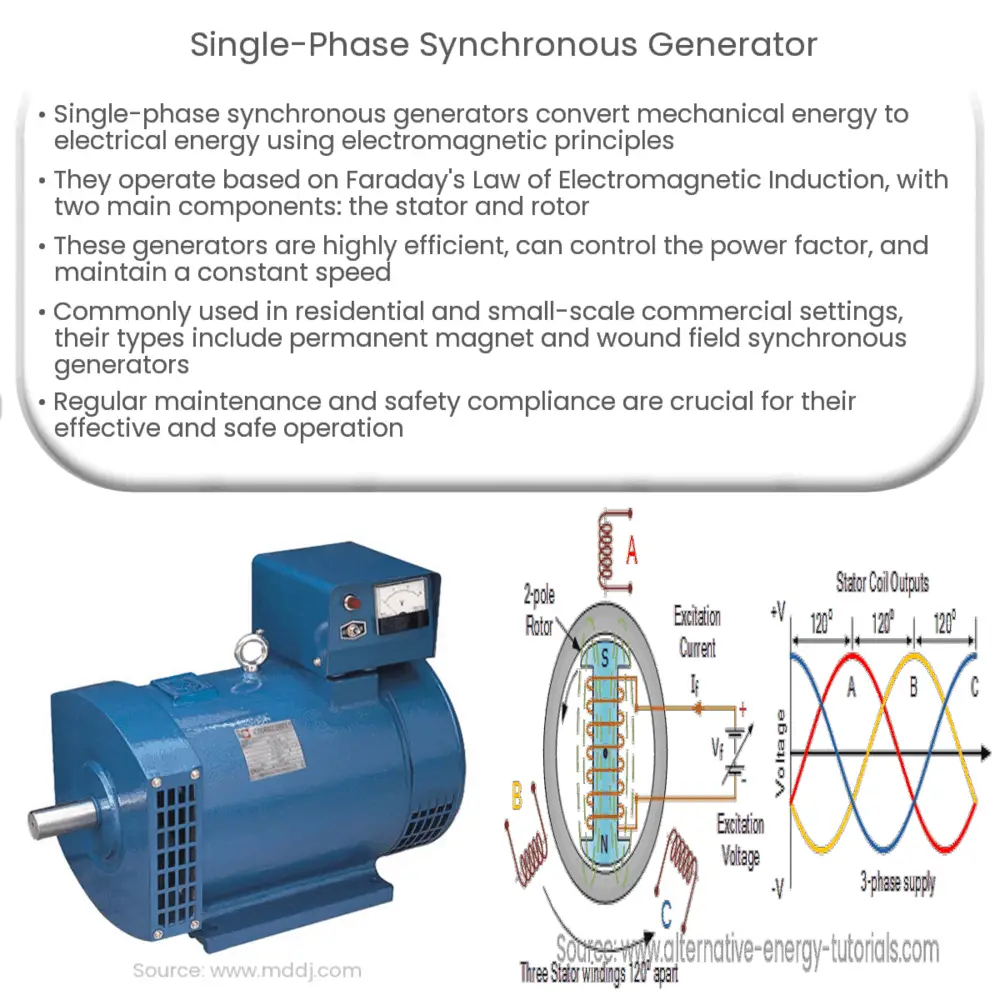Explore the workings, advantages, and applications of single-phase synchronous generators, vital components in power generation systems.

Introduction to Single-Phase Synchronous Generators
A single-phase synchronous generator is an integral component in power generation and distribution systems. This generator type converts mechanical energy to electrical energy using electromagnetic principles, which are essential in the operation of various electrical systems.
Working Principle of Single-Phase Synchronous Generators
Single-phase synchronous generators operate on Faraday’s Law of Electromagnetic Induction. This law states that a change in the magnetic field within a closed loop of wire induces an electromotive force (EMF) in the wire. The generated EMF drives the flow of electric current, creating electrical power.
- Stator: The stator is the stationary part of the generator. It contains an assembly of coils or windings. When the rotor’s magnetic field cuts across these windings, it induces a voltage, causing current to flow.
- Rotor: The rotor is the rotating part of the generator. It contains magnets or electromagnets, which create a magnetic field. This magnetic field rotates with the rotor, cutting across the stator windings.
Key Components of a Single-Phase Synchronous Generator
Single-phase synchronous generators comprise two primary parts: the stator and the rotor. Both components play a critical role in the generation of electricity.
Advantages of Single-Phase Synchronous Generators
- High Efficiency: Single-phase synchronous generators are known for their high efficiency. They are capable of converting a high percentage of the input mechanical energy into electrical energy.
- Power Factor Control: One of the standout features of synchronous generators is their ability to control the power factor. This is achieved by adjusting the field current, thereby impacting the overall system’s efficiency.
- Constant Speed: Synchronous generators operate at a constant speed, synchronous with the frequency of the electrical output. This feature is beneficial in applications requiring a steady and stable frequency.
Applications of Single-Phase Synchronous Generators
Single-phase synchronous generators are commonly used in residential and small-scale commercial environments, where the power requirement is relatively low. They are found in a wide range of devices, including home appliances, small motors, and portable generators.
Types of Single-Phase Synchronous Generators
There are two main types of single-phase synchronous generators: the permanent magnet synchronous generator (PMSG) and the wound field synchronous generator.
- Permanent Magnet Synchronous Generator (PMSG): In PMSGs, the rotor contains permanent magnets to generate the magnetic field. These generators are simple, robust, and require less maintenance as they do not need a separate DC supply for the rotor.
- Wound Field Synchronous Generator: These generators have windings on the rotor, which are supplied with DC power to create the magnetic field. Although they require additional equipment for the DC supply, they provide better control over the generated voltage.
Operating Characteristics
Single-phase synchronous generators are designed to operate at a specific synchronous speed, determined by the frequency of the electrical system and the number of poles in the generator. The output voltage is controlled by varying the field current. These generators can operate either as an isolated system or be connected to an electrical grid.
Maintenance and Safety
Maintenance and safety are important considerations for single-phase synchronous generators. Regular maintenance can help prevent mechanical wear and tear, while safety measures can protect against electrical hazards. It’s essential to comply with applicable codes and standards to ensure safe operation.
Conclusion
In conclusion, single-phase synchronous generators play a crucial role in power generation and distribution systems. They convert mechanical energy to electrical energy efficiently, operate at a constant speed, and offer control over the power factor. With applications ranging from home appliances to small motors and portable generators, these devices significantly contribute to our daily lives. Understanding their working principles, components, advantages, and applications can help in harnessing their potential effectively and safely.


